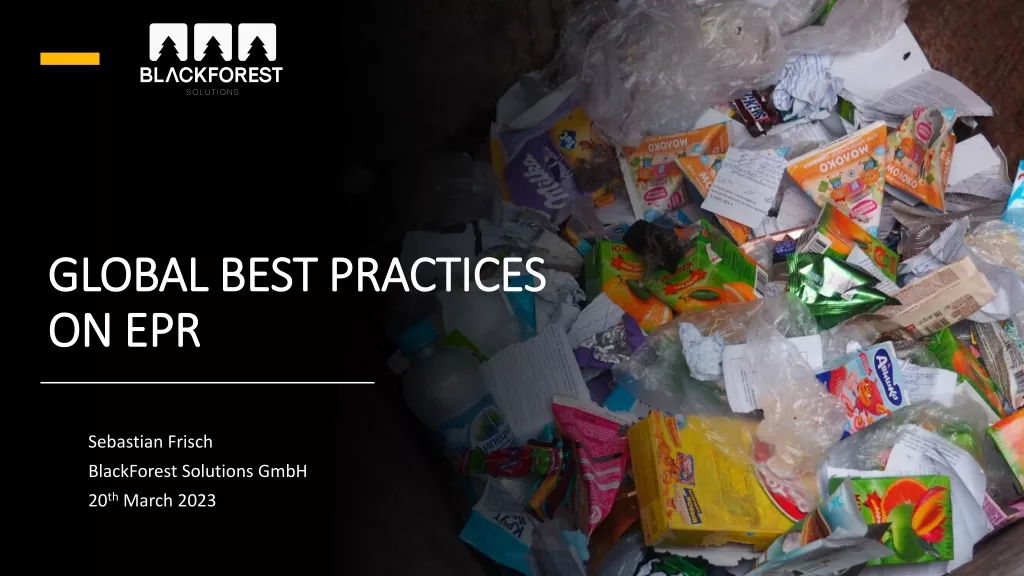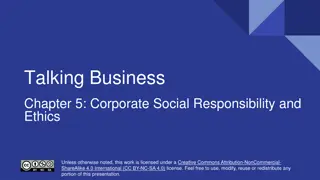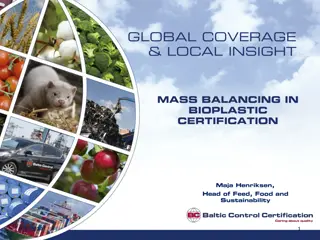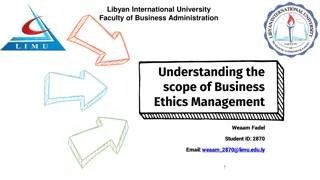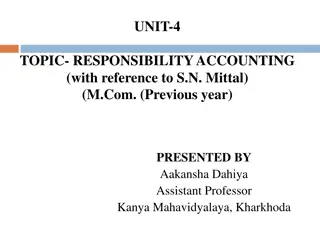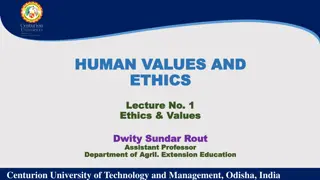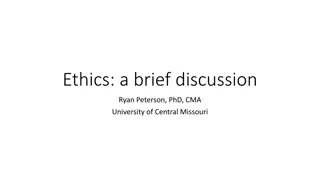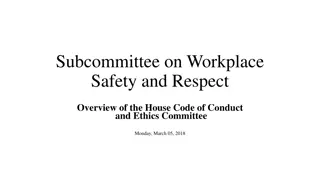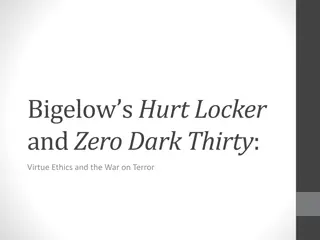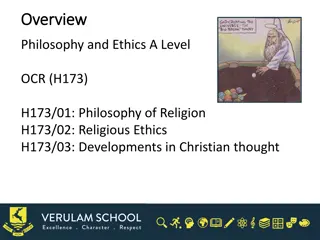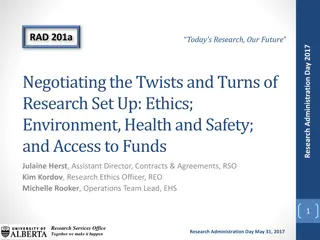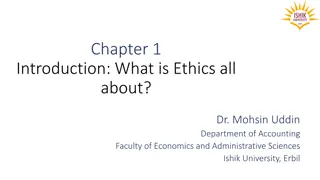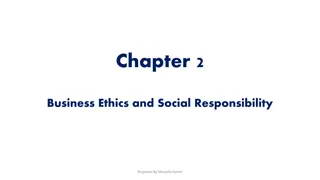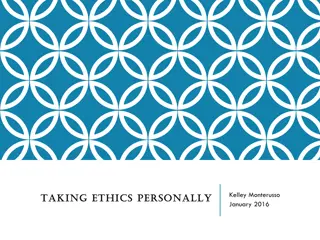Ethics, Social Responsibility, and Sustainability in Management
This presentation explores ethical behaviour, ethical dilemmas in the workplace, maintaining high ethical standards, and the significance of social responsibility, governance, and sustainability. It delves into the intersection of law, values, and ethical behaviour, different views of ethics, and the importance of fundamental rights and justice in ethical decision-making.
Download Presentation

Please find below an Image/Link to download the presentation.
The content on the website is provided AS IS for your information and personal use only. It may not be sold, licensed, or shared on other websites without obtaining consent from the author.If you encounter any issues during the download, it is possible that the publisher has removed the file from their server.
You are allowed to download the files provided on this website for personal or commercial use, subject to the condition that they are used lawfully. All files are the property of their respective owners.
The content on the website is provided AS IS for your information and personal use only. It may not be sold, licensed, or shared on other websites without obtaining consent from the author.
E N D
Presentation Transcript
PowerPoint Presentation to Accompany Management Third Canadian Edition John R. Schermerhorn, Jr. Barry Wright Prepared by: Jim LoPresti University of Colorado, Boulder Revised by: Dr. Shavin Malhotra Ryerson University, Toronto, Ontario
Ethics, Social Responsibility, and Sustainability
Chapter 4 Learning Objectives 4.1 Define ethical behaviour. 4.2 Describe how ethical dilemmas complicate the workplace. 4.3 Explain how to maintain high ethical standards. 4.4 Describe what is social responsibility, governance, and sustainability and explain the significance of each. Management 3e - Chapter4 3
What Is Ethical Behaviour? Ethics Code of moral principles Set standards of good or bad or right or wrong in one s conduct. Ethical behaviour What is accepted as good and right in the context of the governing moral code. Management 3e - Chapter4 4
What Is Ethical Behaviour? Law, Values, and Ethical Behaviour: Legal behaviour is not necessarily ethical behaviour. Personal values help determine individual ethical behaviour. Management 3e - Chapter4 5
What Is Ethical Behaviour? Law, Values, and Ethical Behaviour: Values are broad beliefs about what is appropriate behaviour. Terminal values references about desired ends Instrumental values preferences regarding the means to desired ends Management 3e - Chapter4 6
What Is Ethical Behaviour? Alternative Views of Ethics Utilitarian view greatest good to the greatest number of people Individualism view primary commitment is to one s long-term self- interests Management 3e - Chapter4 7
What Is Ethical Behaviour? Alternative Views of Ethics continued Moral-rights view respects and protects the fundamental rights of all people Justice view fair and impartial treatment of people according to legal rules and standards Procedural justice: policies and rules fairly applied Distributive justice: equal treatment for all people Interactional justice: people treated with dignity and respect Management 3e - Chapter4 8
What Is Ethical Behaviour? Figure 4.1Four views of ethical behaviour. Management 3e - Chapter4 9
What Is Ethical Behaviour? Cultural Issues in Ethical Behaviour: Cultural relativism Ethical behaviour is always determined by cultural context. Cultural universalism Behaviour unacceptable in one s home environment should not be acceptable anywhere else. Considered by some to be ethical imperialism Management 3e - Chapter4 10
What Is Ethical Behaviour? Figure 4.3 Cultural relativism and universalism in international business ethics. Source: Developed from Thomas Donaldson, Values in Tension: Ethics Away from Home, Harvard Business Review, vol. 74 (September-October 1996), pp. 48-62. Management 3e - Chapter4 11
What Is Ethical Behaviour? How international businesses can respect core or universal values: Respect for human dignity: Create a culture that values employees, customers, and suppliers. Maintain a safe workplace. Produce safe products and services. Respect for basic rights Protect rights of employees, customers, and communities. Avoid anything that threatens safety, health, education, or living standards. Be good citizens Support social institutions, including economic and educational systems. Work with local government and institutions to protect the environment. Management 3e - Chapter4 12
Ethics in the Workplace An ethical dilemma occurs when choices, although having potential for personal and/or organizational benefit, may be considered unethical. Ethical dilemmas include: Discrimination Sexual harassment Conflicts of interest Customer confidence Organizational resources Management 3e - Chapter4 13
Ethics in the Workplace Checklist for dealing with ethical dilemmas: Recognize the ethical dilemma Get the facts Identify your options Test each option: Is it legal? Is it right? Is it beneficial? Decide which option to follow Double-check decision by asking spotlight questions: How would I feel if my family found out about my decision? How would I feel about this if my decision were in the local news? Take action Management 3e - Chapter4 14
Ethics in the Workplace Situational Context and Ethics Intensity: Situational context: ethics intensity or issue intensity indicates the degree to which a situation is recognized to pose ethical challenges Personal Factors and Moral Development: Family influences, religious values, personal and financial needs: ethical framework is a personal rule or strategy for making ethical decisions Management 3e - Chapter4 15
Ethics in the Workplace Kohlberg s levels of individual moral development: preconventional level conventional level postconventional level Figure 4.5 Kohlberg s levels of individual moral development Management 3e - Chapter4 16
Ethics in the Workplace Internal Environment and Ethics Culture Supervisory behaviour, peer group norms and behaviour, and policy statements and written rules influence ethical behaviour. External Environment and Industry Norms Government laws and regulations, societal norms and values, and competitive climate in an industry influence ethical behaviour. Management 3e - Chapter4 17
Ethics in the Workplace Ethical behaviour can be rationalized by convincing yourself that: behaviour is not really illegal behaviour is really in everyone s best interests nobody will ever find out the organization will protect you 18 Management 3e - Chapter4
Maintaining High Ethical Standards Whistleblowers Expose the misdeeds of others to: Preserve ethical standards Protect against wasteful, harmful, or illegal acts Laws protecting whistleblowers vary Barriers to whistleblowing include: Strict chain of command Strong work group identities Ambiguous priorities Management 3e - Chapter4 19
Maintaining High Ethical Standards Ethics Training: Structured programs that help participants to understand ethical aspects of decision making. Helps people incorporate high ethical standards into daily life. Helps people deal with ethical issues under pressure. Management 3e - Chapter4 20
Maintaining High Ethical Standards Codes of Ethics: Formal statement of an organization s values and ethical principles regarding how to behave in situations susceptible to the creation of ethical dilemmas. Areas often covered by codes of ethics: Bribes and kickbacks Political contributions Honesty of books or records Customer/supplier relationships Co-worker relationships Confidentiality of corporate information Management 3e - Chapter4 21
Maintaining High Ethical Standards Ethical Role Models: Top managers serve as ethical role models. All managers can influence the ethical behaviour of people who work for and with them. Excessive pressure can foster unethical behaviour. Managers should be realistic in setting performance goals for others. Management 3e - Chapter4 22
Maintaining High Ethical Standards Moral Management: Immoral manager: chooses to behave unethically Amoral manager: fails to consider the ethics of her or his behaviour Moral manager: makes ethical behaviour a personal goal Management 3e - Chapter4 23
Maintaining High Ethical Standards Moral managers influence organizations through: Ethics mindfulness: Enriched awareness that leads to consistent ethical behaviour. Causes a person to behave ethically from one situation to the next. Can affect the ethics of gravity for the organization as a whole. Management 3e - Chapter4 24
Maintaining High Ethical Standards Figure 4.8 Moral management and the ethics centre of gravity in an organization. 25 Management 3e - Chapter4
Maintaining High Ethical Standards Social entrepreneurship: a unique form of entrepreneurship that seeks novel ways to solve pressing social problems at home and abroad Housing and job training for homeless Bringing technology to poor families Improving literacy among disadvantaged youth Offering small loans to start minority-owned businesses Corporate social responsibility: Obligates organizations to act in ways that serve both its own interests and the interests of society at large. Management 3e - Chapter4 26
Social Responsibility, Governance, and Sustainability Stakeholders Those persons, groups, and other organizations directly affected by the behaviour of the organization and holding a stake in its performance. Typical organizational stakeholders Employees Customers Suppliers Owners Competitors Regulators Interest groups Management 3e - Chapter4 27
Social Responsibility, Governance, and Sustainability Perspectives on Social Responsibility: Classical view: management s only responsibility is to maximize profits. Socioeconomic view: management must be concerned for the broader social welfare, not just profits. Management 3e - Chapter4 28
Social Responsibility, Governance, and Sustainability Criteria for evaluating corporate social performance: Social responsibility audit assesses organization s accomplishments in areas of CSR Determine if the organization meets its: economic responsibility; is it profitable? legal responsibility; does it obey the law? ethical responsibility; is it doing the right thing? discretionary responsibility; does it contribute to the broader community? Management 3e - Chapter4 29
Social Responsibility, Governance, and Sustainability Fig. 4.12 Criteria for evaluating corporate social performance. Management 3e - Chapter4 30
Social Responsibility, Governance, and Sustainability Strategies for pursuing social responsibility: Obstructionist meets only economic responsibilities. Defensive meets economic and legal responsibilities. Accommodative meets economic, legal, and ethical responsibilities. Proactive meets economic, legal, ethical, and discretionary responsibilities. Management 3e - Chapter4 31
Social Responsibility, Governance, and Sustainability Figure 4.13 Four strategies of corporate social responsibility from obstructionist to proactive behaviour. Management 3e - Chapter4 32
Social Responsibility, Governance, and Sustainability Corporate governance: The oversight of the top management of an organization by a board of directors. Corporate governance involves: hiring, firing, and compensating the CEO assessing strategy verifying financial records Management 3e - Chapter4 33
Social Responsibility, Governance, and Sustainability Figure 4.14 Ethics self-governance in leadership and the managerial role. Management 3e - Chapter4 34
Social Responsibility, Governance, and Sustainability Sustainability: Development that meets the needs of the present without compromising the ability of future generations to meet their own needs. Sustainability focuses on: social rights environmental protection economic development Management 3e - Chapter4 35
Social Responsibility, Governance, and Sustainability Benefits of sustainability: Cost reduction Resource preservation Legislative compliance Positive reputation Right initiative Management 3e - Chapter4 36
Social Responsibility, Governance, and Sustainability What does a sustainable company look like? CEO leads the charge Board of directors and employees are actively involved Resources are adequately allocated Follows a holistic approach Recognized as a sustainable leader Management 3e - Chapter4 37
Social Responsibility, Governance, and Sustainability Management 3e - Chapter4 38


